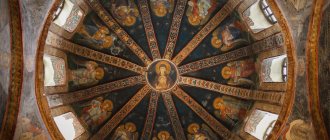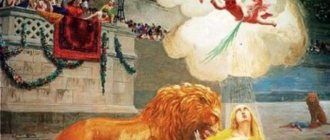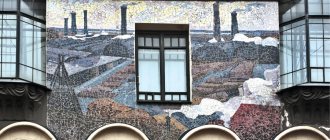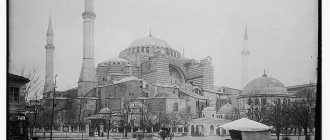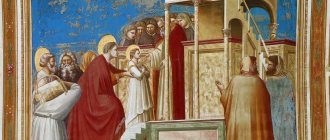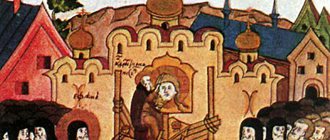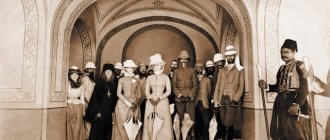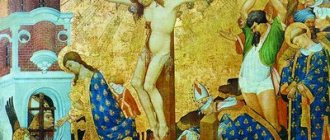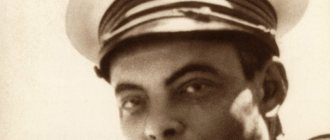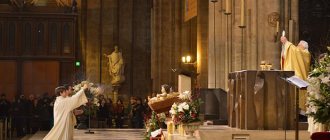Religion:
Miracle on Tolga
Almost 700 years ago - back in 1314, when our land was groaning under the rule of the Tatars - a miracle occurred in the vicinity of Yaroslavl that gave hope to all of Rus'. One day, Bishop Trifon of Rostov, traveling around the northern regions of the diocese, returned along the Volga to Yaroslavl. Caught on the way by darkness, he, together with the priests who were with him, stopped to spend the night on the right bank of the Volga (at the site of present-day Bragin). According to legend, at midnight Tryphon noticed a bright light breaking through the fabric of the tent. Coming out onto the river, he saw a shining pillar on the opposite bank, and a wonderful bridge over the water. Having prayed, Tryphon crossed the bridge over the Volga and at the base of the pillar of fire he saw the image of the Mother of God standing in the air.
Tolga Monastery.
This is how the miraculous Tolga icon, nicknamed after the Tolga river flowing nearby, was found. At the site of the appearance of the image, the saint founded the Church of the Entry into the Temple of the Blessed Virgin Mary and founded the Holy Entry Tolga Monastery. The day of the discovery of the icon - August 21 - began to be celebrated as an Orthodox holiday, and for pre-revolutionary Yaroslavl it was practically City Day. In 1987, the Tolga Monastery was one of the first in the country to be revived, and in 2003 the famous Tolga Icon returned from the museum to the walls of the monastery. As before, thousands of pilgrims come to worship this shrine, and today it is not difficult to get to Tolga even by public transport.
Protected from the Poles
Another miraculous image of the Mother of God is associated in Yaroslavl with the events of the Time of Troubles. This is a list of the icon of the Kazan Mother of God, which is commonly called the Yaroslavl Kazan Icon. At the beginning of the 17th century, it was brought from Kazan by a resident of the city of Romanov (now Tutaev) Gerasim Trofimov. The Mother of God herself ordered him to buy this icon, appearing in a dream. Gerasim carried out the order and soon felt strength in his withered hand. This image also helped other residents of Romanov.
Kazan Monastery.
In 1609 the city was captured by the Poles. They mercilessly plundered churches, not sparing Orthodox shrines. And yet the copy of the Kazan Icon was saved! Among the ranks of the invaders was one “Litvin of the Greek faith.” He hid the wonderful icon from the Poles and sold it to the people of Yaroslavl for a considerable sum. During the 24-day siege of Yaroslavl, the townspeople cried out to this icon for salvation. And then, in the midst of hostilities, one sexton had a vision: the Mother of God promised to protect Yaroslavl and ordered a temple to be built for her image. That's what the Yaroslavl residents did. In 1610, the Kazan Convent was founded in the city, where the miraculous icon remained until the revolution. Today, the main shrine of the Kazan monastery, re-opened in 1998, is the newly miraculous copy of the Yaroslavl Kazan Icon. A beautiful tradition associated with the history of the acquisition of the image has also been revived: every summer the icon goes with a religious procession to Tutaev, and then returns home.
From seven ailments
A story about all the miraculous icons of Yaroslavl and the stories associated with them would take a whole book. Our ancestors knew well which image to go to and with what request. It was believed that the icon of Saints Tikhon and Antipas in the St. Elias-Tikhon Church helped with toothache. And in the Church of St. Blaise, which stood near the city theater, silver figurines of diseased body parts were hung to the icon of St. Panteleimon. In 1922, 10 legs, 2 arms, a heart, an eye and a tooth were removed from the icon...
Nowadays, one of the most famous icons of the Yaroslavl region has become the amazing image of the Mother of God “Addition of Mind”. According to legend, in the 18th century it was painted by an icon painter who suffered from bouts of madness. The icon cured its creator, and people began to turn to it for help in their studies and enlightenment of thoughts. Today the miraculous image “Adding the Mind” is in Tutaev and arrives in Yaroslavl on the eve of September 1. A modern list of this icon is also in the Yaroslavl Church of the Savior on the City. We think that on the eve of the winter session many Yaroslavl residents will want to visit it.
Hometown
The city of Yaroslavl was founded in 1010. It was a wooden fortress around which artisans and traders settled. Sometimes fires broke out in the city, or enemies attacked and set fire to wooden Yaroslavl, and then everything burned down.
After the fire, the residents rebuilt their city, even more beautiful and richer than before.
This continued until the Mongol-Tatars attacked Rus'. In 1238, Yaroslavl was sacked and destroyed by the hordes of Batu Khan.
The city was completely deserted. Its ruler, Prince Vsevolod, died in the battle on the Sit River. Almost the entire Yaroslavl squad died along with him.
Miraculously, the two sons of Prince Vsevolod, Vasily and Konstantin, escaped. They saw a terrible picture when they returned to devastated Yaroslavl. It was necessary to restore the city, support the disadvantaged, widows and orphans. How many centuries have passed since then, and Yaroslavl residents still tell how the Yaroslavl princes Vasily and Konstantin spared the residents of the city, took very small taxes, only “three money per soul,” according to another version, “three chicken eggs.” These princes also avoided participation in internecine princely “squabbles.”
And so the city was reborn. This was largely the merit of two Yaroslavl princes - Vasily and Konstantin.
Both princes were buried in the Assumption Cathedral. In the 16th century, the cathedral was rebuilt and under its ruins the incorruptible relics were found, as they learned from the inscriptions on the coffins, of the holy princes Vasily and Konstantin Vsevolodovich.
Having opened them, they buried them again in the same place. And suddenly a strong storm arose in Yaroslavl with thunder, lightning and torrential rain. This storm lasted for two whole weeks. The residents of Yaroslavl understood that the shrine should not be hidden. The holy relics of princes Vasily and Constantine were solemnly transferred to the newly built cathedral and placed in a chapel consecrated in their honor.
Thus the relics of the holy princes rested peacefully for 243 years, until a fire broke out in the Assumption Cathedral in 1744. On February 20, having extinguished the candles at the end of the service, the guards placed the cinders in a box standing near the shrine with the relics of the holy princes and locked the cathedral. Poorly extinguished cinders caught fire and burst into flames. The flame reached the wooden canopy standing above the shrine, and then spread to the shrine itself. As a result of this fire, the relics of the Yaroslavl princes Vasily and Constantine were burned.
Now they rest in the Fedorovsky Cathedral in Yaroslavl. The memory of Saints Basil and Constantine of Yaroslavl is honored on July 3/16 and June 8/21.
But this happened much later...
In the meantime, Rus' groaned under the yoke of the Mongol-Tatar yoke. It was necessary to pay a huge tribute to the Horde; As soon as the Tatars came running, they robbed and killed. Each prince had to travel to the Horde to receive a label from the khan confirming his right to reign in this city.
This is how the Yaroslavl prince Fyodor Cherny went to the Horde. Yes, in the Horde he not only received a label, but also converted many to the Christian faith. The khan's daughter fell in love with the handsome Yaroslavl prince, married him and accepted her husband's faith - the Christian faith.
In the Horde they had two sons - David and Constantine. Finally, Fyodor Cherny with his wife and children returned to Yaroslavl.
The time of his reign became a time of peace and quiet on Yaroslavl land. The Tatar raids stopped, and the clever Prince Theodore managed to avoid princely civil strife.
Theodore Cherny and his wife Anna built churches in Yaroslavl and ordered beautiful icons for these churches. And this at a time when other cities were experiencing decline and ruin. The reign of Prince Fyodor the Black and his sons David and Konstantin was truly a blessing for Yaroslavl.
These princes were buried in the Spaso-Preobrazhensky Monastery.
For about two hundred years, the relics of the Yaroslavl princes Fyodor the Black and his sons David and Konstantin lay undisturbed. And so in 1463 it was decided to bury them. But when the covers were removed from the dead, numerous miracles and healings began to occur. Taking what happened as a sign, those gathered did not dare to “put the coffin with the princes in the ground.” So in 1463, princes Theodore, David and Constantine were canonized.
The noble princes Fyodor and his children David and Konstantin were revered not only in Yaroslavl, but throughout Rus'. Great and small, rich and poor, came to the holy Yaroslavl princes for blessings. Tsar Ivan the Terrible visited the Spaso-Preobrazhensky Monastery four times, prayed at the relics of the holy princes, and through their prayers, healing was given to Queen Anastasia. In 1612, the militia leaders Minin and Pozharsky, before the campaign to liberate Moscow, resorted to the prayerful help of the Yaroslavl princes. In 1613, the young Tsar Mikhail Fedorovich arrived at the Spaso-Preobrazhensky Monastery with his mother, nun Martha. They also asked for blessings from the holy Yaroslavl princes Fyodor David and Constantine. In 1704, Metropolitan Dmitry of Rostov, using money donated by Yaroslavl merchants, built a new cypress shrine for the relics of the holy princes.
On June 22, the relics were placed in a new shrine. The saint established this day to be celebrated as a day of remembrance for the Yaroslavl wonderworkers.
In 1763, Empress Catherine II visited Yaroslavl and, before going to the Assumption Cathedral, where she was expected, “listened to a prayer service and venerated the relics of the Blessed Princes Theodore, David and Constantine” in the Spaso-Preobrazhensky Monastery.
For several centuries, until the closure of the Spassky Monastery in 1923, people went to the Yaroslavl miracle workers for help and received what they asked for. The holy relics of the noble princes, returned to the Church in 1988, are located in the Feodorovsky Cathedral in Yaroslavl.
Magazine "Our Heritage" - History, Culture, Art
Alexey Fedorchuk
101 icons from Yaroslavl
No one doubted the high level of Yaroslavl icon painting in the 17th century, while later local icon painting was much less known until recently - primarily because most of the monuments were not restored. The opinion that at the beginning of the 18th century Yaroslavl was experiencing some kind of economic and cultural crisis was already expressed in the works of local historians at the turn of the 19th and 20th centuries. The researchers recalled that in 1713, by decree of Peter the Great, trade in some goods through Arkhangelsk was prohibited, and high duties were introduced for the rest. As a result of these innovations, the import and export of goods abroad began to be carried out mainly through the Baltic ports, and Yaroslavl, which was located on the ancient trade route that ran along the Volga and along the Arkhangelsk tract, lost a fair part of its income. The end of the “golden age” in the history of the city, in turn, could not but affect its culture. Without going into details, we note that these arguments presented the economic situation of Yaroslavl in Peter’s time with obvious simplification. But it was they who led to an obvious underestimation of Yaroslavl art of the 18th century.
Recently, the State Tretyakov Gallery hosted an exhibition dedicated to Yaroslavl icon painting of the 17th–18th centuries. Many of its exhibits have been restored over the past decade and for the first time became available to both specialists and a wide range of lovers of ancient Russian painting. The works presented at the exhibition made it possible to destroy the established stereotype and convincingly proved the continuity in the development of art in Yaroslavl throughout the 17th–18th centuries.
Yaroslavl icon painters of the 18th century carefully preserved the best achievements of their predecessors and enriched the style they developed, that is, a certain system of artistic techniques that made local icons easily recognizable. In the composition of icons, the Yaroslavl people preferred balanced, centric structures. The special monumentality of the images was combined with the artists’ passion for detail and an abundance of ornaments on clothes and architectural buildings. The coloring of the icons, although somewhat changing over time, retained bright color accents - including the bright red cinnabar and deep emerald green that were especially beloved by the Yaroslavl residents. The types of faces, patterns of features and color combinations used in personal writing were also quite stable.
The formation of local traditions of icon painting was facilitated by the very nature of the work of artists of the 17th century, most of whom came from the urban settlement. The most capable were assigned to the sovereign's Armory Chamber to participate in large artistic works at the royal court (for example, in the painting of the Assumption and Archangel Cathedrals of the Moscow Kremlin). Staying in the capital, fulfilling a responsible order as part of a single artel with leading masters from Moscow and other cities enriched the Yaroslavl residents with new artistic techniques and expanded their artistic horizons. From there, from the capital, artists brought new drawings—sample drawings that were used to create new works.
The artel method of work was practiced at this time not only in Moscow, but also in other cities, including Yaroslavl itself, where artels, consisting of local and visiting craftsmen, were involved in the painting of numerous churches and the creation of iconostases. In the artel, artists differed in their specialties: “znamenschik” - who created (“signified”) the drawing and, as a rule, performed the most important part of the image - the faces; “dolichnik” - one who wrote clothes; “herbalist” - who created ornaments, etc. This “division of labor” was used not only in monumental painting, but also in icon painting - for example, on the icon of Stepan Zavyazoshnikov “The Nativity of Christ” of 1786, in the loss of the author’s paint layer on the ground, letters-marks were visible, with which the artist apparently marked for the apprentice, the color of one or another detail of the image.
This organization of work in the icon-painting workshop brought together the individual creative style of the artists. The artels also established an apprenticeship system - the secrets of the artistic craft, as was customary in the Middle Ages, were inherited from teacher to student, most often from father to son. By the second half of the 17th century, dynasties of icon painters were emerging in Yaroslavl, many of whom worked successfully in the next century, during a period when the calls of provincial masters for government work in Moscow and St. Petersburg ceased. Thus, it was the presence in the city of hereditary artists who inherited the art traditions of an earlier time that largely ensured the stability of the local artistic style in the 18th century.
Local customers also contributed to the preservation of the stylistic unity of Yaroslavl icon painting. Unfortunately, not a single contract for the creation of icons has survived to this day. But if we proceed, for example, from the surviving contracts for the production of a carved gilded iconostasis, concluded by the parish of the Church of Elijah the Prophet in the 1690s, it becomes clear that the customer played an important role in determining both the appearance and style of the new work. Thus, in particular, these documents name particularly liked details in one of the earlier iconostases, which are proposed to be repeated. This focus on patterns also contributed to the preservation of traditions.
Innovations were introduced into the Yaroslavl icon very gradually. Of course, the concept of “new”, “modern”, “fashionable” in a certain context existed in the Middle Ages. Thus, already in the 17th century, non-resident artists were invited to Yaroslavl, whose works attracted the attention of customers. Among them were Kostroma resident Gury Nikitin, Ustyug resident Fedor Zubov, and Kholmogorsk resident Semyon Spiridonov. It is under their influence that Yaroslavl residents begin to paint more and more images in green and red tones, enriching the color of their works with colored varnishes and the finest gold ornaments.
Nevertheless, among the icon painters who came to the city, masters of a more archaic type predominated, inheriting in their work the techniques of the so-called Stroganov school at the turn of the 16th–17th centuries. The Stroganovites were famous for their honed craftsmanship, exquisite miniature painting and work using the gold-gold writing technique. They created icons that were more similar to works of jewelry, which should have especially appealed to wealthy Yaroslavl merchant customers. It seems that masters of the “live-like”, pro-Western orientation were not liked in Yaroslavl. New artistic techniques, due to the influence of Baroque and later classicism, appeared in local painting gradually, without violating the integrity of works traditional in spirit.
Along with complex multi-figure compositions, often executed using the technique of miniature writing, Yaroslavl icon painting created images that were monumental in form and, at the same time, quite expressive. The painting of monumental icons for wooden churches in the first half of the 17th century was probably due to the need to achieve maximum expressiveness and grandeur of church interiors with a small number of works. Yaroslavl residents could not afford a large number of icons during the restoration of the city after the Polish devastation. Among the best works of this time is the image of the Mother of God of Korsun, coming from the Church of Demetrius of Thessalonica.
By the middle of the 17th century, Yaroslavl reached the peak of its economic development. First, wealthy merchant families, and then individual parishes, began building stone churches. Already the earliest stone parish churches were very large, resembling city and monastery cathedrals in type. In such churches there should have been images commensurate with them in terms of the scale of perception - such as “Simeon the God-Receiver”, “Bringing the Apostle Peter out of prison”, “Elijah the Prophet in the Wilderness”, as well as icons with selected saints praying in front of the icons of the Great Savior Bishop and Our Lady of Tolga, and some others. The commitment to monumentality continued in Yaroslavl art in the 18th century, as evidenced by the “Our Lady of All Who Sorrow Joy”, “Savior the Great Bishop” and “Savior Not Made by Hands” presented at the exhibition.
Another direction of creative search by Yaroslavl artists involved the creation of icons in which the content was revealed in maximum detail in numerous miniature stamps. The particular prevalence of such images in the 17th century was predetermined by the tastes of the customers of the icons, whose roles in parish churches were most often trading people - merchants. Due to the nature of their occupation, they traveled a lot and received many new impressions, on the basis of which a new vision of the world gradually emerged - diverse and mobile, filled with people and events. This, in turn, could not but affect their aesthetic tastes and preferences.
Extended cycles of images in stamps were most often dedicated to the life of the saint represented in the center of the icon. These are the icons of the martyr Theodore Stratelates, St. John Chrysostom, St. Demetrius of Prilutsk, Catherine the Great Martyr, and the Evangelist Matthew. Icon painters loved to illustrate in stamps the texts of liturgical chants and prayers, as well as various legends, mainly about miraculous icons. Some of these icons were presented at the exhibition: “Praise of the Mother of God, with an akathist”, “Annunciation, with the “joys” of the Mother of God” and the image of the Mother of God of Vladimir with marks of miracles. A special group consists of frame icons, which were created when updating iconostasis for ancient shrines - in order to emphasize their significance. Thus, already in the middle of the 17th century, a frame with passion marks was made for the icon of the Savior Almighty. The frame of the “Our Lady of Yaroslavl” icon, a prayer image of the holy Yaroslavl princes Vasily and Constantine, located in the city’s Assumption Cathedral, dates back to the end of the 18th - beginning of the 19th centuries.
From the middle of the 17th century, icons in which individual scenes did not form a strict geometric series of marks, but were picturesquely arranged over the entire surface of the icon board, became widespread in Yaroslavl. Most often, a similar compositional principle was used in images of the Nativity of Christ. There are more than a dozen similar icons in the collection of the Yaroslavl Museum. The earliest of them, from the mid-17th century, and the later, executed in 1786 by Stepan Zavyazoshnikov, were presented at the exhibition.
The desire for monumental images and a special love for detail and entertaining plots led to the appearance in Yaroslavl of icons of a special type, combining a large monumental image of the saint with separate scenes-stamps, which were freely located on the background and on the ground. Perhaps one of the first to paint such icons was Ustyug resident Fyodor Evtikhiev Zubov, one of the leading masters of the Moscow Armory, invited by the Skripin merchants to work in the Church of Elijah the Prophet. At the exhibition at the Tretyakov Gallery, one of the few indisputable works of this master that has come down to us was exhibited - the icon “Ilya the Prophet in the Desert,” dated 1672.
The central image of Elijah seated on a stone is complemented by scenes from the life of the prophet, inscribed in the landscape background. The same technique twenty years later, in 1692, was used by the icon painter Andrei Savin (a native of the village of Velikoye) when painting the image of “Epiphany”. A similar compositional solution is present in the icon “St. John Chrysostom,” created by a Yaroslavl icon painter at the beginning of the 18th century. On its ground, on the sides of the figure of the saint, there are two marks with scenes of the birth of John Chrysostom and the transfer of his relics. Large figures of saints and small miniature stamps on the ground are combined with even greater grace and proportionality in the images of the first half of the 18th century - “Reverend Paul of Thebes and John Kushchnik, with scenes from their lives” and “Reverend Zosima and Savvaty of Solovetsky”.
An important achievement of the exhibition, in my opinion, was the demonstration of not only the stylistic unity, but also the iconographic diversity of Yaroslavl icons. Based on the set of subjects that have become widespread in local art, one can to some extent judge the worldview of the Yaroslavl people, their most important historical, cultural and spiritual guidelines.
From the beginning of the 17th century, images began to be painted in abundance in Yaroslavl, illustrating church chants. So, for example, in the church inventories of the 19th century that have reached us, almost every church mentions the icon “Rejoices in You.” The text of the hymn, which compared the Mother of God with the “sanctified church” and “verbal paradise,” allowed the artist to depict on such icons paradise with a host of saints praising the Mother of God, and the saints were depicted in strict accordance with the idea of the harmonious structure of the heavenly world - in strict rows, according to ranks: forefathers, prophets, apostles, saints, martyrs and reverend women. The image of the saints by rank was to be perceived as an image of all humanity living in unity, harmony and prayer. The plot of “He rejoices in You” could be so beloved by the people of Yaroslavl precisely because it reflected their ideas about the ideal, reasonable structure of the universe. It is interesting that the spread of this iconography on Yaroslavl soil begins in the 17th century, immediately after the events of the Time of Troubles, in which Yaroslavl had the opportunity to play such an important role.
In 1612, a militia came to the city from Nizhny Novgorod under the leadership of Prince Dmitry Pozharsky and the townsman Kozma Minin. In Yaroslavl, the “Council of the Whole Earth” was formed, to which all cities sent their representatives. Other bodies of state power were also created in Yaroslavl, including orders that directed individual territories and state affairs (such as, for example, the palace and monastery). Coins were minted here, ambassadors were sent to Austria from here and negotiations were conducted with the Swedes. Thus, the city actually served as the capital of the state for four months. The residents of Yaroslavl were able to see by their own example the difficulties of achieving unity and the need for agreement to overcome chaos and “unrest.” Perhaps it was from that time that the theme of conciliarity, a single prayerful presence, characteristic of Russian Orthodoxy as a whole, was developed especially widely in Yaroslavl art.
Numerous icons with images of selected saints, represented in prayer to one image or another, were also associated with this theme. Two of them, originating from the Yaroslavl Kazan Monastery, are extremely important for understanding the worldview of the Yaroslavl people at the end of the 17th century.
The icons are paired: one of them depicts the Moscow metropolitans Peter, Jonah, Alexey and Philip and blessed Vasily and Maxim in prayer to the image of the Great Savior Bishop, and on the other - the holy Yaroslavl princes Vasily and Konstantin, Feodor, David and Konstantin and the Venerable Macarius of Unzhensky praying to the image of the Mother of God of Tolga. There is clearly a specific program behind the selection of saints on the icons. The first one presents Moscow saints, patrons of the capital of the Russian state and the reigning Romanov dynasty. Between the figures of saints, a much lost image of a city has been preserved, in which the real buildings of the Moscow Kremlin can be discerned. The second icon depicts the holy Yaroslavl princes from the first dynasty - brothers Vasily and Konstantin - and the founder of the second Yaroslavl princely dynasty - the holy noble prince Fyodor Cherny (Smolensky) with his sons David and Konstantin. The princes offer their prayers to the Tolga Icon of the Mother of God, who, according to legend, appeared in 1314 and was revered as the protector and patroness of Yaroslavl.
It is interesting that, in addition to the Yaroslavl miracle workers, this icon represents the Kostroma venerable Macarius of Unzhensky, canonized under Mikhail Romanov in 1619 (in 1620, the Unzhensky monastery was visited by the king himself with his mother, nun Martha, on a pilgrimage, which was supposed to emphasize the all-Russian significance of the new cult ). Such a combination of saints on the Yaroslavl icon was probably meant to remind us that the Romanovs’ ascension to the royal throne, which began in Kostroma, was also connected with Yaroslavl and would hardly have been possible without the heroic efforts of local residents in 1612. Only awareness of the historical significance of one’s hometown and its services to the entire country could lead to the creation of such a work. It is curious that in the 19th century, during the renewal of the icons, their programmatic nature was not entirely clear to the master icon painter, as a result of which the holy Prince Alexander Nevsky and St. Mitrofan of Voronezh, patrons of the Russian Empire, were painted over the figures of the blessed, and the Venerable Macarius of Unzhensky was replaced by the saint Demetrius of Rostov, especially revered in the Yaroslavl diocese. Icons began to be perceived only as a comparison of the national and local cults of saints.
Another monument comes from the Kazan Monastery, which clearly reveals the peculiarities of the historical self-awareness of the Yaroslavl people. This is a frame painted at the end of the 17th century with picturesque marks from the miraculous Yaroslavl-Kazan Icon of the Mother of God. The central vertical of the frame is occupied by an image of the Holy Trinity and three marks with compositions glorifying the Virgin Mary. On the sides and at the top there are stamps telling about the discovery of the miraculous Kazan Icon of the Mother of God and the creation of a copy of it by order of Ivan the Terrible, as well as about numerous healings from the shrine. Four marks in the lower corners of the frame are dedicated to the history of the Yaroslavl-Kazan icon. According to the legend, an angel who appeared in a dream to a resident of the small Volga town of Romanov, Gerasim, who was ill with an “eye disease,” ordered him to go to the city of Kazan and there, in the icon row, exchange a copy from the famous shrine - the miraculous image of the Kazan Mother of God. Gerasim did so, after which, returning home, he took the icon to the St. Nicholas Church and began to persuade the Romanovites to build a new church for it. Residents of the town did not agree to this, and the icon remained in the St. Nicholas Church until 1609, when Romanov was captured by the Poles. One of the nobles took the icon of the Mother of God from the temple abandoned by the townspeople, and later, during the siege of Yaroslavl by the troops of False Dmitry II, he gave it to the Yaroslavl zemstvo elder Lytkin. The residents of Yaroslavl believed that the city was saved from the Polish capture by the shrine brought to the fortress, and in memory of the siege and the special patronage of the city by the Yaroslavl-Kazan Icon of the Mother of God, they subsequently founded the Kazan Monastery.
It is also noteworthy that in the marks of the frame made for the miraculous Yaroslavl icon, there is a visual comparison of two copies of the Kazan Icon - the Yaroslavl and the Moscow, commissioned by Ivan the Terrible. The miraculous Yaroslavl icon itself has not reached our time, and at the exhibition one of the early copies was inserted into its frame, differing from the original in the images of saints in the margins.
The tradition of performing repetition lists from ancient shrines can be traced throughout the history of Yaroslavl icon painting. Among such lists, the exhibition presented, first of all, images of the Mother of God: Korsunskaya, Vladimirskaya, Khlynovskaya, Bogolyubskaya, Kazanskaya. The famous local images also received special attention from Yaroslavl residents, including the temple icon of the Church of the Archangel Michael on Kotorosl, executed, according to legend, in 1299 by order of Princess Anna, the second wife of the Yaroslavl prince Fyodor the Black. The ancient icon is currently in the main exhibition of the State Tretyakov Gallery, and at the exhibition one could see a copy of it, made at the beginning of the 18th century. In the 18th century they wrote a lot of repetitions of the miraculous image of the Savior Not Made by Hands, which several times saved the city from pestilence. One of these lists, dated 1757, was also presented at the exhibition. The cult of local shrines is also associated with an 18th-century copy of a fresco depiction of the martyr Thomaida on the porch of the Yaroslavl Church of John the Baptist in Tolchkovskaya Sloboda. It is noteworthy that lists from such shrines were often ordered even for temples located in close proximity to the places where the miraculous images themselves resided. The presence of such a list in the temple was supposed to remind believers again and again that they were under heavenly protection and patronage.
The idea of divine patronage for Yaroslavl received its most consistent expression in the program of icon-frames for the miraculous image of the Mother of God of Yaroslavl, located in the Assumption Cathedral. It was written in 1803 by Ivan Smirnov. In the center of the frame are depicted the holy Yaroslavl princes Vasily and Konstantin, holding in their hands the icon of the Mother of God of Yaroslavl, which, according to legend, was their home prayer image. On the sides of the princes, in cartouches, are images of the most revered Mother of God icons of the Christian world and scenes of the miracles of the Mother of God. At the top of the frame are the Holy Trinity and the Mother of God, from which light emanates onto the globe (a hemisphere with two rivers, the Volga and the Yaroslavl Kotorosl), crowned with an image of the Yaroslavl Assumption Cathedral.
How in Yaroslavl the relics of Holy Prince Theodore Rostislavovich were returned to the Church
On October 2, the Russian Orthodox Church celebrates the day of the blessed princes Theodore the Black and his children David and Constantine, the Yaroslavl miracle workers. Our readers will be interested to know how their relics were returned to the believers after decades of persecution of the church. Let us recall that the head of the Volgograd diocese, Metropolitan Theodore, received the name of the blessed prince during his monastic tonsure, which took place in Yaroslavl 20 years ago.
In the late 80s and early 90s of the last century, churches began to actively return the relics of saints. Everyone remembers how the relics of Father Seraphim of Sarov, Patriarch Tikhon, were found. Saints from the basements of museums and the crypts of closed churches were released.
In Yaroslavl in 1988, on the eve of the celebration of the 1000th anniversary of the Baptism of Rus', the relics of the holy noble prince Theodore the Black with his sons David and Constantine were returned to the church. They were kept in the depository of the Yaroslavl Museum-Reserve, in its branch, the Church of St. Nicholas Nadein.
Here's how journalist Marina Shimanskaya talked about it:
That summer day in 1988, when a wooden box with the relics of Prince Fyodor Cherny and his sons was brought to the Spaso-Preobrazhensky Monastery from the Church of St. Nicholas Nadein, I remember it like no other day in ten years of working in the museum. At that time, churches, icons, and even holy relics for us, museum employees, were nothing more than monuments of history and culture, which we were called upon to study and preserve for posterity. They did this honestly, reverently, and with great love for all antiques. And before our eyes, one of the storage objects, the relics of the Yaroslavl princes, began to live their own church life, completely unfamiliar to us. Its representatives - people in robes - came for them to our museum, which was once their monastery.
In the smallest room of the ancient cellars, a prayer service began in front of the relics. It was impossible to find a “better” place to avoid publicity: it was so crowded that you could neither get in nor get out. But we could not miss such an unusual event and gathered not far from the building, carefully watching what was happening. Everyone wanted to see what the relics looked like and what the priests did with them? What force drew me there, I guess only now, but then I would never have explained how I decided to squeeze through to the relics through a dense wall of strangers in church robes. And so I found myself in front of a wooden box with cloth-covered relics, I discerned three dark skulls and a slightly raised arm bone in the middle.
And in 1938, the relics became one of the main exhibits of the anti-religious museum that opened in Yaroslavl in the Church of Elijah the Prophet. In order to scientifically expose the clergy of deception, the relics were sent for examination. And we must pay tribute to the doctors of that time, who were not afraid to write an opinion on the authenticity of the relics. Recognizing their antiquity and amazing preservation, they made a conclusion unexpected for scientists: “... the last word about the reasons for the preservation of the bodies of princes Theodore, David and Constantine belongs to the mind and religious conscience of the people.”
The museum existed for several years and was closed in 1941 - its director went to the front. And the relics of the noble princes Fyodor, David and Konstantin ended up in the Church of St. Nicholas Nadein, which in the 30s was used as a repository for museum funds, during the war years as a hospital warehouse, and in 1959 it became part of the museum-reserve.
It remains a mystery when and how the holy relics got there. According to museum legend, they were transferred to the temple at night by museum employees. To hide it more reliably, they deliberately did not include them in the fund books. Next to them lay other relics, the origin of which was unknown. When in the 80s the new head of the architectural department E.A. Ankudinova took over the cases, in the church of Nikola Nadein they told her: “This is Fyodor Cherny with his sons, and next to him is no one knows who.” For some reason, the unidentified relics were called the “Siberian Mummy.” Museum restorer A.F. Chertorizhskaya regularly came to the temple to keep them in order. And if the relics of the princes did not require care, the “mummy” often had to be wiped down.
During the tourist season, excursions were held in the Church of St. Nicholas Nadein. And sometimes museum workers secretly allowed those who asked for it to see the relics. In 1987, E.A. Ankudinova brought her close friends to the relics - they were looking for help in having children. They didn’t come out of strong faith—out of hopelessness. And the saints responded: in 1988, a young couple had three girls! The doctors were unable to save one, but two grew up safely and became good, kind people with whom I know well. This story remained only in the memory of the people involved in it - miracles were not recorded in museum documents.
In the summer of 1989, Archimandrite Mikhei (Kharkharov), at that time the rector of the Fedorov Cathedral, came to the retired Metropolitan John (Wendlend) with joyful news: the relics were being given away, and now they would be in their cathedral! He said that it was planned to dress them in linen robes according to Russian custom. To which Vladyka objected: “Blessed Feodor was a schema-monk, and he must be clothed in monastic robes. And his sons are princes, they must be clothed in brocade.”
Metropolitan John gave the blessed Fedor a gift: he gave him his new monastic robe made of natural silk, of such good quality that it did not even have to be ironed - all 40 folds were one to one. When, a few days later, Vladyka John received communion from Father Igor Maltsev, he asked him: “Did the saint accept my gift?” “He did!” Got it! - Father Igor nodded joyfully...."
The relics remained in the Fedorovsky Church for twenty years, until the Assumption Cathedral appeared on the Volga, built for the 1000th anniversary of Yaroslavl by philanthropist V.I. Tyryshkin. Of course, the main shrine of the city should have been located only there. And on October 1, 2011, the shrine with the relics, mounted on the carriage of an armored personnel carrier, went to the new cathedral.
What is the fate of the “Siberian mummy”? The “unknown person” was missing a phalanx on his finger. Museum workers knew about this distinctive feature. And as it happens, someone was at the right time, in the right place, one said, the other heard. At the same time, an anatomical description of the relics of St. Innocent of Irkutsk and a photographic recording of the procedure for their opening were discovered in Irkutsk.
There was no doubt: the “Siberian mummy” without a phalanx of a finger was the holy relics of Innocent of Irkutsk. This was a real miracle for the people of Irkutsk. There they believed that the relics of the saint were in the Museum of Religion and Atheism in Leningrad.
Further events developed like this. The ruling bishop of Irkutsk, Bishop Vadim, arrived in Yaroslavl. The relics were examined. Everything has been confirmed! (Metropolitan Vadim (Lazebny) will head the Yaroslavl diocese in thirty years.)
The Lord showed a miracle. Sixty-nine years of desecration of the shrine and neglect of it could not destroy the incorruptible relics of St. Innocent, Bishop of Irkutsk. Members of two commissions, both from March 12, 1990, and from August 9 of the same year, secular people, doctors, museum workers, restorers, representatives of the Yaroslavl Committee for Religious Affairs, all of them were amazed at the strength of the body of St. Innocent. On the eve of the Feast of the Transfiguration of our Lord Jesus Christ, on August 18, the relics of St. Innocent left the museum walls, their last secular refuge. They were transported to the newly opened Tolgsky Monastery, awaiting departure to their homeland. Before departure, important matters had to be settled.
The fact is that, both according to the law and according to the mentality of the Soviet leaders, the relics of the saint were a corpse. And the corpse must be transported under strict observance of certain conditions: in a mail and luggage car, in a sealed metal coffin, placed in a wooden box, the free space of which is filled with sawdust.
The fathers who came from Irkutsk for the holy relics could not allow such sacrilege. In addition, they did not have money for such expensive transportation. Anyone who remembers the early 90s will not be at all surprised by this.
And then one of the active parishioners figured out how to do it. And she began to attack the head of the Northern Railway. And this is a very big position to understand. The Northern Railway serves nine regions. Its management is located in Yaroslavl. Nowadays, the majority of townspeople do not know the name of the head of SZD, but in the nineties it was the second governor. For example, in difficult times, the regional authorities borrowed money from him to pay salaries.
The plan was this: to block the entrance to the last vestibule of the tail car for passengers, and place a coffin with relics there. At what point under the pressure of the envoy from the people the boss broke down, history is silent. Rumor has it that the prospect that his entire family would be remembered in heaven until the end of time did not leave the tall railway worker indifferent.
So in the last vestibule of the railway passenger train his heavenly patron went to Irkutsk.
Elvira Mezhennaya
Photo by Sergei Metelitsa
(182)
Share:
Orthodox Sarov
A group of 20 parishioners of Sarov churches, led by Archpriest Alexander Sukhotkin, went on a pilgrimage on June 8-9. One of the trip participants, Irina Vorontsova, tells the story.
Organizing the trip was not easy, the dates were postponed, and there were fewer people than usual, but the team was friendly. Among the pilgrims were entire families and very elderly people; There were those who were used to traveling and newcomers. But everyone lovingly supported each other and steadfastly endured the hardships of the journey, especially the heat of over 30 degrees, and no one was capricious. The hours spent on the road, on the bus, were greatly brightened up by the stories of Father Alexander, a cheerful, cheerful and erudite man.
After praying, we left Sarov on the evening of Friday, June 7th. After spending the night on the road, we arrived in the Yaroslavl region, at the Tolga Holy Vvedensky Convent, founded in 1314 on the site of a miraculous discovery in the forest near the river. Tolga of the icon of the Mother of God. We bowed to the miraculous revealed Tolga icon; this is one of the few well-preserved originals of the 14th century. During Soviet times, the icon was kept in the Yaroslavl Art Museum, and in 2003 it was returned to the monastery. Of the other shrines, the most memorable are the relics of St. Ignatius Brianchaninov and the myrrh-streaming copy of the miraculous Seraphim-Ponetaevskaya icon “The Sign”.
This monastery is very beautiful, clean and calm, you feel some kind of peace. Everything around is well-groomed, there are flowers, ponds with ducks are pleasing to the eye, peacocks fan out their tails. The monastery has its own farm, the sisters make dairy products, honey, jam and much more. The nuns are friendly and welcoming, love emanates from them.
We visited the cedar grove at the monastery; it was planted in the 16th century. Once in the monastery, which was then a men's monastery, there was a strong fire. But the Tolga Icon was not damaged; it was found on a tree not far from the monastery. Tsar Ivan the Terrible was healed from this icon in 1553; with his funds, a cedar grove was planted and a chapel was erected at the site where the icon was found. According to legend, Ermak himself gave cones of Siberian cedar to Ivan the Terrible. In order for the cedars to take root, they needed special care and a complex drainage system. Before the revolution, more than 200 trees grew there, and then, when the monastery fell into disrepair, the trees began to die.
For many years, a children's colony was located on the territory of the Tolga monastery. And local residents retained the memory that this place was blessed, and came to pray in the cedar grove. The authorities did not like this, and they decided to demolish the most powerful giant cedar. The ancient tree did not give in for a long time. The nun-tour guide said that an old woman came to them, who was then a girl and saw all this with her own eyes. When the cedar trunk was cut down with great difficulty, the image of the Mother of God became clearly visible on the stump of annual rings. Even more people flocked there to see the miracle. Then they uprooted the stump and roots of the tree...
In this amazing grove on a hot summer day we enjoyed the coolness and pine smell, which reminded me of the mountain forests of Crimea. The Tolga Monastery left an unforgettable impression on my soul.
From there we went to Kostroma. We spent the night in an inexpensive hostel, and in the morning we began sightseeing at the Church of the Resurrection of Christ on Debra. This is the only surviving 17th-century posad church in the city. At first it was made of wood, and around 1650 it was rebuilt in stone. The name of the temple indicates that there were forest jungles there. The temple is unusually beautifully decorated on the outside and all painted on the inside; behind the modern iconostasis you can see another, ancient iconostasis. Until 1991, the miraculous Feodorovskaya icon of the Mother of God, brought to Kostroma from Gorodets, was kept in this temple until 1991. And now this icon is in the Epiphany Anastasia Convent of Kostroma, where we also visited.
Anastasia's monastery was founded by a disciple and relative of St. St. Sergius of Radonezh Nikita, former abbot of the Serpukhov Vysotsky Monastery. His St. the relics are in the Anastasia Monastery. We attended a prayer service and liturgy there, and some of our parishioners received Holy Communion. Praying near the Feodorovskaya icon, many felt the heat emanating from it, and tears welled up in their eyes. There was a feeling of contact with a living shrine.
In the same monastery there is a Cross, which contains particles of the relics of 278 saints! Their names are indicated at the base of the cross. There we first saw the icon of rights. Elizabeth with the baby John the Baptist in her arms, and for a long time they could not understand who was depicted on her, it looked like the Mother of God, but, it seemed, not her...
The ancient Holy Trinity Ipatiev Monastery on the banks of the Volga is called the “cradle of the House of Romanov.” During the Time of Troubles, the youth Mikhail Romanov lived there with his mother Martha, and from there he was called to the kingdom. It is interesting that the last Sovereign of the Romanov family was shot in the Ipatiev House in Yekaterinburg. According to legend, the Ipatiev Monastery in Kostroma was founded in the 14th century by the Mongolian official Chet, fulfilling the command of the Most Holy Theotokos. He received holy baptism with the name Zechariah.
The main shrine of the Ipatiev Monastery is the Tikhvin Icon of the Mother of God, which in 1613 was brought to Kostroma by the ambassadors of the Zemsky Sobor, calling young Mikhail Fedorovich to the royal throne.
During a sightseeing walking tour of the city, we saw in the park an interesting monument in the form of a mountain made of huge pieces of granite. Before the revolution, they wanted to install 28 sculptures of the predecessors of Emperor Nicholas II on these granite ledges. But these figures were destroyed, and the top of the monument was crowned with a single statue of Lenin. From below it seems ugly and disproportionate...
On these hot days, we simply rested in the coolness of the monasteries with their walls several meters thick. And I honestly admit that I fell in love with Kostroma. I had no idea that small towns in the outback could be so beautiful, quiet and surrounded by greenery. With a two-story city center and some special spirit. A river flows nearby and ships sail. Beauty!
On the way home to Sarov, we stopped in Suzdal. Having entered the temple, we “accidentally” met a woman who turned out to be a historian, and she showed us the shrines of this city, as much as time allowed. We visited the Intercession Convent, where we venerated the relics of St. Sophia of Suzdal and in the Deposition of Robe Monastery, at St. relics of St. Euphrosyne of Suzdal. The lives of these holy women made a very big impression on me, I won’t retell it, read it for yourself. I will only say that St. Childless spouses pray to Sofia, and many children are born. The monastery records evidence of miraculous events.
I would like to thank the organizers and Father Alexander, who accompanied us, for a wonderful trip. It brought parishioners together and allowed them to touch the hitherto unknown shrines of our Motherland.
Pilgrimage / 20190609-To the holy places of Yaroslavl and Kostroma

